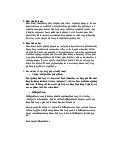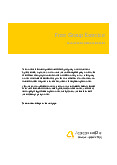




Preview text:
Types of Retailers Department stores
Department stores have a product mix under one roof, each representing a distinct
merchandise line and staffed with a limited number of salespeople. Table 12-2 lists
major department stores that have expanded outside their home-country markets.
However, in most instances, the expansion is limited to a few countries. Specialty Retailers
Specialty Retailers offer less variety than department stores. They are more narrowly
fo- cused and offer a relatively narrow merchandise mix aimed at a particular target
market. Specialty stores do offer a great deal of merchandise depth (e.g., many styles,
colors, and sizes), high levels of service from knowledgeable staff, and a value
proposition that is both clear and appealing to consumers.
EX:The Body Shop, Victoria’s Secret, Starbucks Supermarkets
Supermarkets are departmentalized, single-story retail establishments that offer a
variety of food (e.g., produce, baked goods, meats) and nonfood (e.g., paper products,
health and beauty aids) items, mostly on a self-service basis. On average, supermarkets
occupy between 50,000 square feet and 60,000 square feet of floor space. UK-based
Tesco is one retailing group that is expanding globally. Convenience stores
Convenience stores offer some of the same products as supermarkets, but the
merchandise mix is limited to high-turnover convenience and impulse products. Prices
for some products may be 15 to 20 percent higher than supermarket prices.
In the United States, for example, the typical 7-Eleven occupies 3,000 square feet. 7-
Eleven is the world’s largest convenience store chain; it has a total of 26,000 locations,
including franchisees, licensees, and stores the company operates itself.
A trend in convenience store retailing is toward smaller stores placed inside malls,
airports, office buildings, and in college and university buildings. Discount retailers
Discount retailers can be divided into several categories. The most general
characteristic that they have in common is the emphasis on low prices.
Full-line discounters: typically offer a wide range of merchandise, including nonfood
items and nonperishable food, in a limited- service format.
Ex: Walmart is the reigning king of the full-line dis- counters
Warehouse clubs: shoppers “join” the club to take advantage of low prices on a limited
range of products (typically 3,000 to 5,000 different items)
(Memberships fees; Ex. Sam’s Costco ) Dollar stores Sell at a single low price;
Ex. in U.S. Family Dollar, Dollar Tree, Internationally, My Dollar store has rapid growth in the industry Hard discounters
Hard discounters: These discounters offer a limited assortment of goods—typically
1,000 to 3,000 different items—at rock-bottom prices.
Ex: Aldi - is the joint brand of two German family-owned discount supermarket chains
with more than 10,000 stores in 20 countries Hypermarkets
Hypermarkets are a hybrid retailing format combining the discounter, supermarket, and
warehouse club approaches under a single roof. Size-wise, hypermarkets are huge,
ranging from 200,000 to 300,000 square feet. Ex: emart, aeon Supercenters
Supercenters offer a wide range of aggressively priced grocery items plus general mer-
chandise in a space that occupies about half the size of a hypermarket. Superstores
Superstores (also known as category killers and ) is the label many in the big-box retail
retailing industry use when talking about stores such as Toys ‘R’ Us, Home Depot, and
IKEA. The name refers to the fact that such stores specialize in selling vast assortments
of a particular product category—toys or furniture, for example—in high volumes at low prices. Shopping Mall
Shopping malls consist of a grouping of stores in one place. Developers assemble an
assort- ment of retailers that will create an appealing leisure destination; typically one
or more large de- partment stores serve as anchors. Outlet Stores
Outlet stores are a variation on the traditional shopping mall: retail operations that
allow com- panies with well-known consumer brands to dispose of excess inventory,
out-of-date merchandise, or factory seconds. To attract large numbers of shoppers,
outlet stores are often grouped together in outlet malls.
Trends in Global Retailing Environmental Factors
Currently, a variety of environmental factors have combined to push retailers out of
their home markets in search of opportunities around the globe. Saturation of the
home-country market, recession or other economic factors, strict regulation on store
development, and high operating costs are some of the factors that prompt
management to look abroad for growth opportunities. Critical Question
The critical question for the would-be global retailer is, “What advantages do we have
relative to local competition?”.
A retailer may have several things to offer consumers, such as selection, price, and the
overall manner and condition in which the goods are offered in the store setting. Store
location, parking facilities, in-store atmosphere, and customer service also contribute to
the value proposition. Competencies can also be found in less visible value-chain
activities such as distribution, logistics, and information technology.




